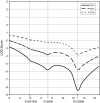Exclusion of COL2A1 and VDR as developmental dysplasia of the hip genes
- PMID: 18288556
- PMCID: PMC2504671
- DOI: 10.1007/s11999-008-0120-z
Exclusion of COL2A1 and VDR as developmental dysplasia of the hip genes
Abstract
Developmental dysplasia of the hip (DDH) is a spectrum of disorders affecting the proximal femur and/or acetabulum leading to an abnormal formation of the hip. Genetic factors are involved in the etiology of DDH. Early recognition of DDH affords the best results from treatment and a better knowledge of the genetics of DDH could enhance early diagnosis. Variants in the Type II collagen (COL2A1) and vitamin D receptor (VDR) genes have been associated with patients with osteoarthritis of the hip secondary to DDH, suggesting these genes could contribute to DDH. To see whether there was linkage between the COL2A1/VDR locus and nonsyndromic DDH, we conducted a linkage study on 11 families with multiple cases of DDH. We demonstrated no evidence of linkage between the COL2A1/VDR locus and nonsyndromic DDH (LOD score < -2), suggesting, although variants in these genes could play a role in osteoarthritis in patients with DDH, they do not contribute to nonsyndromic DDH. The search for causal gene variants should proceed with other candidates.
Figures




References
-
- {'text': '', 'ref_index': 1, 'ids': [{'type': 'DOI', 'value': '10.1002/ajmg.1320530408', 'is_inner': False, 'url': 'https://doi.org/10.1002/ajmg.1320530408'}, {'type': 'PubMed', 'value': '7864044', 'is_inner': True, 'url': 'https://pubmed.ncbi.nlm.nih.gov/7864044/'}]}
- Beighton P, Cilliers HJ, Ramesar R. Autosomal dominant (Beukes) premature degenerative osteoarthropathy of the hip joint unlinked to COL2A1. Am J Med Genet. 1994;53:348–351. - PubMed
-
- None
- Canepa G, Pelizza A, Pietrogrande V. Le malattie dello scheletro nell’età evolutiva. Vol 1. Padova, Italy: Piccin; 1987.
-
- {'text': '', 'ref_index': 1, 'ids': [{'type': 'DOI', 'value': '10.1097/00003086-196400330-00010', 'is_inner': False, 'url': 'https://doi.org/10.1097/00003086-196400330-00010'}, {'type': 'PubMed', 'value': '5889015', 'is_inner': True, 'url': 'https://pubmed.ncbi.nlm.nih.gov/5889015/'}]}
- Carter CO, Wilkinson JA. Genetic and environmental factors in the etiology of congenital dislocation of the hip. Clin Orthop Relat Res. 1964;33:119–128. - PubMed
-
- {'text': '', 'ref_index': 1, 'ids': [{'type': 'PubMed', 'value': '6746674', 'is_inner': True, 'url': 'https://pubmed.ncbi.nlm.nih.gov/6746674/'}]}
- Catterall A. What is congenital dislocation of the hip? J Bone Joint Surg Br. 1984;66:469–470. - PubMed
-
- {'text': '', 'ref_index': 1, 'ids': [{'type': 'DOI', 'value': '10.1002/ajmg.1320360403', 'is_inner': False, 'url': 'https://doi.org/10.1002/ajmg.1320360403'}, {'type': 'PubMed', 'value': '2389793', 'is_inner': True, 'url': 'https://pubmed.ncbi.nlm.nih.gov/2389793/'}]}
- Cilliers HJ, Beighton P. Beukes familial hip dysplasia: an autosomal dominant entity. Am J Med Genet. 1990;36:386–390. - PubMed
Publication types
MeSH terms
Substances
LinkOut - more resources
Full Text Sources
Research Materials

